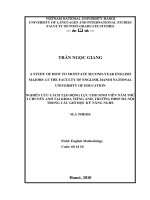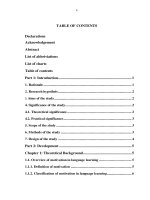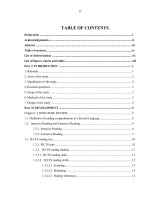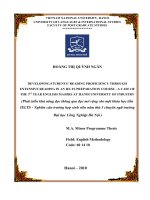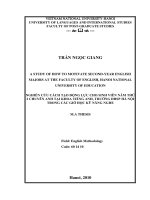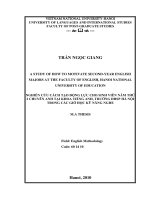Using role play in teaching short stories to third year english majors at the university of technical education in ho chi minh city m a
Bạn đang xem bản rút gọn của tài liệu. Xem và tải ngay bản đầy đủ của tài liệu tại đây (5.09 MB, 193 trang )
VIETNAM NATIONAL UNIVERSITY - HO CHI MINH CITY
UNIVERSITY OF SOCIAL SCIENCES AND HUMANITIES
DEPARTMENT OF ENGLISH LINGUISTICS AND LITERATURE
********************
THESIS
USING ROLE-PLAY IN TEACHING SHORT STORIES
TO THIRD-YEAR ENGLISH MAJORS
AT THE UNIVERSITY OF TECHNICAL EDUCATION
IN HO CHI MINH CITY
Submitted to the
Department of English Linguistics and Literature
in partial fulfillment of the Master’s degree in TESOL
By
TRAN THI THIEN THANH – TESOL 2008
Supervised by
DOAN HUE DUNG, Ph.D.
HO CHI MINH CITY, 2013
STATEMENT OF AUTHORSHIP
I certify my authorship of the Master’s Thesis submitted today entitled
“USING ROLE-PLAY IN TEACHING SHORT STORIES TO THIRD-YEAR
ENGLISH MAJORS AT THE UNIVERSITY OF TECHNICAL EDUCATION
IN HO CHI MINH CITY”
In terms of the Statement of requirements for Theses in Masters’ programs
issued by the Higher Degree Committee of the Department of English Linguistics and
Literature, University of Social Sciences and Humanities, Vietnam National
University of Ho Chi Minh City.
The thesis has not been accepted for any degree and it is not currently
submitted in candidature of any other degree.
Ho Chi Minh City, 2013
Tran Thi Thien Thanh
i
RETENTION AND USE OF THE THESIS
I hereby state that, I, TRAN THI THIEN THANH, being a candidate for the
degree of Master of Arts (TESOL) accept the requirements of the University relating
to the retention and use of Master’s Thesis deposited in the Library.
In terms of these conditions, I agree to the original of my thesis being deposited
in the Library to be accessible for the purpose of study and research, in accordance
with the normal condition established by the Librarian for the care, loan or
reproduction of theses.
HCMC, 2013
TRAN THI THIEN THANH
iii
ACKNOWLEDGEMENTS
I would first like to express my deepest gratitude to my supervisor Dr. Doan
Hue Dung for her great encouragement, sympathy and support during my research. I
appreciate her generosity and very detailed suggestions on various drafts of this thesis.
Without her guidance and support this research could not have been completed.
In addition, I am thankful to the teachers who helped to answer the
questionnaire and my students at Faculty of Foreign Languages at the University of
Technical Education who assisted in data collection. I would also like to thank Dr.
Nguyen Dinh Thu for his instructing me to teach literature and his care and
encouragement.
I want to express my gratitude to all of the professors who devotedly taught me
during my postgraduate studies at the USSH. In addition, I want to say thank you to
all of my classmates, TESOL 2008 class, especially Mr. Huynh Phong Nhuan,who
have inspired and encouraged me, spiritually and practically, during the study process
and compilation of this thesis.
Finally I would like to send my special thank to my family who always
encouraged and helped me during this study.
iv
ABSTRACT
This thesis is a study of applying role play in teaching American short stories.
The study aims to examine the effects of role play in teaching and learning American
literature. Its goals are set to find out (1) students’ attitude toward learning American
literature and (2) the effect of applying role-play in the context of teaching and
learning American short stories.
As for the framework of analysis, the study involved 15 teachers in charge of
American literature and 59 students majored in English at the Faculty of Foreign
Languages at the University of Technical Education. The research instruments
included questionnaires for both teachers and students and pre-tests and post-tests for
students only.
The major findings of the study revealed that both students and teachers
appreciate the various effects of role play in teaching American short stories,
especially enhancing the comprehension of short stories; however, not many teachers
apply it very often in their literature teaching for different reasons.
Key words: role play, literature, American short stories, comprehension.
v
TABLE OF CONTENTS
STATEMENT OF AUTHORSHIP............................................................................... ii
RETENTION AND USE OF THE THESIS................................................................ iii
ACKNOWLEDGEMENTS.......................................................................................... iv
ABSTRACT ................................................................................................................... v
TABLE OF CONTENTS ............................................................................................. vi
LIST OF FIGURES ....................................................................................................... x
LIST OF TABLES ....................................................................................................... xii
LIST OF ABBREVIATIONS..................................................................................... xiii
1.
CHAPTER 1 INTRODUCTION.......................................................................... 1
1.1 Background to the Study ............................................................................................ 1
1.2 Rationale .................................................................................................................... 3
1.2.1. Teaching and learning literature at high school level .............................................. 3
1.2.2. Teaching and learning British and American literature at English-majored
tertiary level ................................................................................................................. 4
1.2.3. Teaching and learning British and American literature at HCMCUTE ................... 4
1.3 Aims of the study ....................................................................................................... 6
1.4 Research questions..................................................................................................... 6
1.5 Hypothesis ................................................................................................................. 7
1.6 Significance of the study ............................................................................................ 7
1.7 Limitations of the study ............................................................................................. 8
1.8 Research Method ....................................................................................................... 8
1.9 Organization of the study ........................................................................................... 9
2.
CHAPTER 2 LITERATURE REVIEW ............................................................ 11
2.1 Literature in English Language Teaching ................................................................. 11
2.2 Literary Text Selection ............................................................................................ 13
2.3 Short Stories ............................................................................................................ 15
vi
2.3.1 Definition.............................................................................................................. 15
2.3.2 Characteristics of a Short Story ............................................................................. 16
2.3.2.1. Setting ............................................................................................................ 16
2.3.2.2. Plot
............................................................................................................ 17
2.3.2.3. Characters ......................................................................................................... 17
2.3.2.4. Theme ............................................................................................................ 18
2.3.2.5. Point of view ..................................................................................................... 19
2.3.3 Problems When Using a Short Story ..................................................................... 19
2.3.4 Approaches to Teaching Short Stories................................................................... 20
2.3.3.1. Elements of the Short Story ............................................................................... 21
2.3.3.1.1. Visualizing the setting .................................................................................... 21
2.3.3.1.2. Seeing conflicts .............................................................................................. 21
2.3.3.1.3. Understanding decisions ................................................................................. 21
2.3.3.1.4. Sensing tone and mood .................................................................................. 21
2.3.3.1.5. Seeing character ............................................................................................. 22
2.3.3.1.6. Understanding character ................................................................................. 22
2.3.3.1.7. Understanding the plot ................................................................................... 22
2.3.3.1.8. Seeing the sequence of events ........................................................................ 22
2.3.3.1.9. Understanding the story line ........................................................................... 23
2.3.3.1.10. Understanding structure................................................................................ 23
2.3.3.2. Interpreting and Understanding the Short Story................................................. 24
2.3.3.3. Writing the Short Story ..................................................................................... 25
2.4 Methodological Approaches to Teaching Literature ................................................. 32
2.4.1 Language-based approach ..................................................................................... 33
2.4.2 Information-based approach .................................................................................. 33
2.4.3 Critical literacy approach ...................................................................................... 34
2.4.4 Stylistic approach.................................................................................................. 34
2.4.5 Story Grammar approach ...................................................................................... 35
2.4.6 Reader Response approach.................................................................................... 35
2.4.7 Integrated approach ............................................................................................... 36
2.4.8 Task-based approach ............................................................................................. 36
2.5 Role play ................................................................................................................. 39
2.5.1 Definition.............................................................................................................. 39
2.5.2 Reasons for using role play in English classes....................................................... 40
vii
2.5.3 Disadvantages of Using Role play......................................................................... 43
2.5.4 Types of role play ................................................................................................. 45
2.5.4.1 Role-playing controlled through cued dialogues................................................. 46
2.5.4.2 Role-playing controlled through cues and information ....................................... 47
2.5.4.3 Role-playing controlled through situation and goals........................................... 48
2.5.4.4 Role-playing in the form of debate or discussion................................................ 49
2.5.4.5 Large-scale simulation activities ........................................................................ 50
2.5.4.6 Improvisation ..................................................................................................... 51
2.5.5 The procedure to conduct a role play..................................................................... 51
2.5.5.1 Preparation and explanation of the activity by the teacher .................................. 52
2.5.5.2 Student preparation of the activity ...................................................................... 54
2.5.5.3 Carry out role play ............................................................................................. 55
2.5.5.4 The discussion or debriefing after the role-play activity ..................................... 57
3.
CHAPTER 3 METHODOLOGY....................................................................... 60
3.1 A Brief Overview on the Theory of Experimental Research ..................................... 60
3.2 Research Design ...................................................................................................... 61
3.3 The Experimental Teaching ..................................................................................... 62
3.3.1. Characteristics of Student Participants ................................................................. 62
3.3.2. Experimental Teaching ........................................................................................ 62
3.4 Characteristics of Teacher Participants..................................................................... 64
3.5 Instruments Used in Data Collection ........................................................................ 64
3.5.1 Questionnaires ...................................................................................................... 64
3.5.1.1 Pre-questionnaire ............................................................................................... 65
3.5.1.2 Post-questionnaire .............................................................................................. 66
3.5.1.3 Teachers’ questionnaire...................................................................................... 68
3.5.2 Pre-test ............................................................................................................... 69
3.5.3 Post-test ............................................................................................................... 69
3.6 Data Analysis ........................................................................................................... 70
3.7 Research Procedure.................................................................................................. 70
4.
CHAPTER 4 DATA ANALYSIS AND DISCUSSION OF RESULTS ............ 73
4.1. Data Analysis .......................................................................................................... 73
4.1.1 Questionnaires for Students................................................................................... 73
viii
4.1.1.1 Pre-questionnaire ............................................................................................... 73
4.1.1.2 Post-questionnaire .............................................................................................. 79
4.1.1.2.1 Part 1: Same questions for both classes ........................................................... 79
4.1.1.2.2 Part 2: Questions for the experimental class only............................................. 88
4.1.2 Tests
............................................................................................................... 97
4.1.3 Teachers’ questionnaire....................................................................................... 105
4.2. Major Findings...................................................................................................... 120
5.
CHAPTER 5 CONCLUSIONS ........................................................................ 124
5.1. Answering the research questions ......................................................................... 124
5.2. Implications .......................................................................................................... 126
5.2.1. Increase students’ interest in reading literary works ........................................... 127
5.2.2. Enhance role-play’s effects in the literature lesson ............................................. 128
5.3. Recommendations for Further Study ..................................................................... 128
REFERENCES .......................................................................................................... 130
APPENDICES .......................................................................................................... 134
APPENDIX 1 Students’ Pre-Questionnaire ................................................................ .135
APPENDIX 2 Students’ Post-Questionnaire (Controlled class) ............................ ……137
APPENDIX 3 Students’ Post-Questionnaire (Experimental class) .............................. .139
APPENDIX 4 Teachers’ Questionnaire ...................................................................... .142
APPENDIX 5 Test ..................................................................................................... .145
APPENDIX 6 Sample lesson plan (Controlled class) .................................................. .155
APPENDIX 7 Sample lesson plan (Experimental class) ............................................. .167
APPENDIX 8 A sample role play script (A Gift of the Magi)..................................... .179
ix
LIST OF FIGURES
Figure 2-1: Plot pattern of a short story.......................................................................... 17
Figure 2-2: Anticipating student problems with short stories ................................................. 20
Figure 4-1: Respondents’ opinions of their favourite skill.............................................. 74
Figure 4-2: Respondents’ opinions of literature role ...................................................... 74
Figure 4-3: Respondents’ love of literature .................................................................... 75
Figure 4-4: Respondents’ opinions of the obstacles of studying literature ...................... 77
Figure 4-5: Respondents’ choice of favourite literature genre ........................................ 78
Figure 4-6: Teaching activities in the previous literature course..................................... 78
Figure 4-7: Awareness of literature role before/after course in the controlled class ........ 80
Figure 4-8: Awareness of literature role before/after course in experimental class ......... 80
Figure 4-9: Comparison of obstacles to studying literature before and after the course
in the controlled class .................................................................................................... 81
Figure 4-10: Comparison of obstacles to studying literature before and after the course
in the experimental class ................................................................................................ 81
Figure 4-11: Time spent on reading a work before each lesson ...................................... 82
Figure 4-12: Difficulty of reading the assigned works ................................................... 83
Figure 4-13: Character Incarnation ................................................................................ 84
Figure 4-14: Frequency of rereading the works after lessons ......................................... 85
Figure 4-15: Feeling when studying the course .............................................................. 86
Figure 4-16: Favourite class activities............................................................................ 87
Figure 4-17: Level of understanding a lesson ................................................................. 87
Figure 4-18: Level of Enjoying Role-play...................................................................... 89
Figure 4-19: Course Recommendation ........................................................................... 89
Figure 4-20: Role-play’s effect on memorizing story details .......................................... 90
Figure 4-21: Role-play’s effect on understanding a story without reading it................... 91
Figure 4-22: Role-play’s effect on interest in literature .................................................. 92
Figure 4-23: Role-play’s effect on story comprehension ................................................ 93
Figure 4-24: Role-play’s effect on creativity.................................................................. 94
Figure 4-25: Role-play’s effect on team-work spirit....................................................... 94
x
Figure 4-26: Role-play’s effect on confidence ............................................................... 95
Figure 4-27: Role-play’s effect on sense of empathy ..................................................... 96
Figure 4-28: Role-play’s effect on love of literature....................................................... 96
Figure 4-29: Literature’s role ....................................................................................... 106
Figure 4-30: Favorite teaching genre ........................................................................... 107
Figure 4-31: Obstacles of Teaching Literature ............................................................. 107
Figure 4-32: Frequency of using role-play ................................................................... 108
Figure 4-33: Reasons of using role-play....................................................................... 109
Figure 4-34: Reasons of disusing role-play .................................................................. 110
Figure 4-35: Role-play’s effect on the interest in literature .......................................... 111
Figure 4-36: Role-play’s effect on the comprehension of literary works ...................... 112
Figure 4-37: Role-play’s effect on creativity................................................................ 112
Figure 4-38: Role-play’s effect on confidence ............................................................. 113
Figure 4-39: Role-play’s effect on sense of empathy ................................................... 114
Figure 4-40: Role-play’s effect on the love of literature ............................................... 114
Figure 4-41: Suitable genres for role-play .................................................................... 115
Figure 4-42: Suitable lesson stage for role-play ........................................................... 116
Figure 4-43: Story summary before performance ......................................................... 117
Figure 4-44: Use of role-play in the future ................................................................... 118
Figure 4-45: Suggested improvements for applying role-play ...................................... 119
xi
LIST OF TABLES
Table 1-1: The outline of American Literature course at FFL, HCMCUTE ................ 6
Table 2-1:Discussion input chart............................................................................... 21
Table 2-2: Lesson plan frame.................................................................................... 32
Table 3-1: Implied Purposes from the Student Pre-Questionnaire ............................. 66
Table 3-2: Implied Purposes from the Student Post-questionnaire ............................ 67
Table 3-3: Implied Purposes from the Teacher Questionnaire ................................... 69
Table 4-1: The respondents’ reasons for little interest in literature in the controlled
class.......................................................................................................................... 75
Table 4-2: The respondents’ reasons for little interest in literature in the experimental
class.......................................................................................................................... 76
Table 4-3: Pre-Test and post-test results ................................................................... 97
Table 4-4: Test items categorized into comprehension skills................................... 103
Table 4-5: Summary of post-test results according to comprehension skills ............ 105
xii
LIST OF ABBREVIATIONS
HCMUTE
Ho Chi Minh University of Technical Education
FFL
Faculty of Foreign Languages
USSH
University of Social Sciences and Humanities
xiii
1. CHAPTER 1
INTRODUCTION
This thesis studies Role-play as an approach in enhancing advanced learners’
comprehension of English and American short stories. Primarily set in Literature
classes of FFL of HCMCUTE the research employs the experimental method. The
first chapter of the thesis presents some factors that may affect the study, specifies the
problems and aims of the study, and briefly describes the methodology.
1.1 Background to the Study
Literature is a very versatile subject and is generally considered one of the
most difficult subjects to teach and to study. Studying native literature in native
language is not easy at all; however, it cannot be compared with American and British
literature in English, an extremely difficult task which challenge many Vietnamese
students. Understanding literary language requires more efforts than dealing with
spoken language. Therefore, literature subject is often in the list of the most
unfavourable subjects. When being asked about their opinion toward the subject at the
beginning of the course, the students do not conceal their negative attitude toward
literature subject. They assume that studying literature is very boring; they gradually
lose the sense of pleasure and enjoyment that go with the study of literature. Their
explanation is rooted from the high school time when they studied Vietnamese
literature with fear or scare; likewise, English literature at university is not an
exception.
To address this phenomenon, the problems in studying and teaching
English literature may be listed as follows.
The first problem is students’ lack of clear goals and objectives. Undoubtedly,
if a student does not know the aims of studying literature, he or she will probably not
get the pleasure or satisfaction in studying literature. Numerous students claim that
literature is useless in their daily life, and that they cannot use literary language in
both daily and working communications. However, literature obviously plays an
inevitable role which is claimed by Maxim Gorky, the famous Russian writer:
i
The aim of literature is to help man to understand himself, to strengthen the
trust in himself, and to develop in him the striving toward truth; it is to fight meanness
in people, to learn how to find the good in them, to awake in their souls shame, anger,
courage; to do all in order that man should become nobly strong.1
Therefore, the teacher’s duty is to present the clear and practical objectives at the
beginning of the course and the learning aims or outcomes in each lesson.
The second problem may be blamed on the dissymmetry between the difficult
language in literary works, especially of old English and students’ low level of
English. Unique literary words, transcendent ideas, or unusual writing styles are some
noticeable hindrances to students’ understanding and interest in prose or poetry.
Choosing a masterpiece novel to teach is not a matter, but making the learners master
its content, meaning and especially stylistic devices is a quite different story. Due to
the study timetable constraint, students cannot be required to read the whole novel
and analyze it in less than a week. Consequently, a short story should be used instead
of a novel.
Last but not least, the most important cause for the students’ boredom is the
teaching method. A pensive class atmosphere and passive and sleepy students are all
blamed on two continuous hours or more of listening to the lecturing in non-native
language. Students sit passively trying to struggle against sleepiness in order to take
note every word transmitted to their ears. They do not trigger their mind at all; they
accept all opinions about the characters, themes, and so on presented by the teacher as
if they were undeniable facts. As a result, students do not participate in the process of
understanding and evaluating characters’ psychology and then refer the work to their
real situations.
All of the above problems can be solved only when the literature teaching
approach is changed in a positive way. This means that students will be involved in
1
Cited from “Maxim Gorky: A Political Biography” (1999:35) by Tova Yedlin
2
the lesson, searching a way to understand the meaning of the story by themselves. The
teacher plays the role of a facilitator who guides students to a thorough and correct
comprehension. With this discipline in mind, the teacher can motivate students by
applying role-playing activities. Role-play in which students are assigned certain roles
to act can enhance students’ comprehension of literature texts as well as their interest
in studying literature. However the effects of applying role-play in teaching literature
need to be verified by a research. The findings of the research will help literature
teachers to decide to what extent or whether role-play activities should be applied.
Moreover, the findings will be the answers to the problems above and bring pleasure
to English literature classes.
1.2 Rationale
1.2.1.
Teaching and learning literature at high school level
At high school level, literature is considered one of the core subjects with the
scores multiplied by a factor of 2. However, “There have been various articles which
reflected the critical decrease in the quality of the teaching and learning of literature in
recent years.”2 The reasons for this disappointing fact include the followings. First,
due to the social demands for technological or economic development, most of the
high school students are in favour of natural sciences subjects like maths, physics, and
chemistry instead of social sciences subjects like literature.3 They do not read the
works before class and pay little attention to the teachers’ lectures. Second, the
purpose of teaching literature at schools is not to nurture their soul but to help them to
pass exams, especially the high school graduation exam which is a burden for both
teachers and students. The teaching method and content focus on the format and
content of the exams which have remained unchanged for years. Students learn by
heart sample answers, and guided analysis essays. Other factors that hindrance
students’ interest in literature consist of class time limitation and long and old works.
2
Roughly translated from the article “BAO GIỜ CHẤT LƯỢNG DẠY VÀ HỌC VĂN ĐƯỢC CẢI THIỆN?”
by Thuý Hồng (Giáo dục và Thời đại, Tuesday 18 Aug. 2009)
3
“Thực trạng học văn của học sinh trường THPT hiện nay” by Nguyễn Thị Bình
/>
3
In conclusion, teaching and learning literature has not helped to increase students’
aspiration but has made them frightened at this subject.
1.2.2.
Teaching and learning British and American literature at English-
majored tertiary level
According to an MA research carried out at the Department of English
Linguistics and Literature, USSH in 2010, the majority of surveyed students are fairly
interested in studying literature. More than half of them study literature because it is
mandatory to them. It means that they are forced to study this subject and find it not
very interesting. As a result, they do not participate in the lessons positively. Most of
them blame their disinterest on the language of the studied works and the teaching
methods. They claim that some teachers with their passive style are unable to inspire
them, causing them to learn it simply to pass the exam. Some other teachers impose
their own opinions and interpretation on the students, not allowing them to feel
literature in their own way. The students also complain that they are not provided with
essential background information of the literary work.
1.2.3.
Teaching and learning British and American literature at
HCMCUTE
The thesis focuses on the context of the third-year students at the Faculty of
Foreign Languages, HCMCUTE. At the beginning of the junior year, after finishing
the British and American civilization courses, students begin to study British literature
followed by American literature course. Both of the courses aim at providing the
students with the essential literary terms, concepts, literature trends, authors and
masterpieces. On successful completion of the courses, students are expected to be
able to (i) present their understanding of the characteristics of literature trends,
authors’ styles and genres, (ii) systematize the aforementioned knowledge and analyze
the chosen works in terms of meaning and literary devices. The British literature
course includes some introductions to the prose and poetry terms besides the
knowledge of British literary trends, authors and works. The American literature
4
course, on the other hand, focuses mainly on American literary trends, authors and
works, especially short stories. Therefore, the latter course is favourable for the study
to be carried out. The course lasts 45 periods over 15 weeks with three forty-fiveminute periods each week as shown in Table 1-1.
WEEKS PERIODS
1
1-3
CONTENT
- General introduction of the course
+ Objectives
+ Requirements
- Overview of American history and Literature periods
- Characteristics of American Literature
2
4-6
3
7-9
4
10-12
REVOLUTIONARY LITERATURE, 1776–1820
Washington Irving
Rip Van Winkle
Washington Irving
Rip Van Winkle (Cont’d)
ROMANTIC PERIOD: 1820–1860
Poetry
Transcendentalism
The Fireside poets
Fiction
Nathaniel Hawthorn
Edgar Allan Poe
Herman Melville
5
13-15
The Brahmin poet
H.W. Longfellow
The Tide Rises The Tide Falls
6
16-18
7
19-21
8
22-24
9
25-27
10
28-30
Emily Dickinson
Because I Could not Stop for Death
The Rise Of Realism: 1860-1914
Kate Chopin
The Story of an Hour
O. Henry
The Gift Of The Magi
Mid-term test
MODERNISM and EXPERIMENTATION: 1914-1945
5
11
12
31-33
E. Hemingway
34-36
Hills Like White Elephants
E. Hemingway
Hills Like White Elephants (Cont’d)
13
37-39
Shirley Jackson
The Lottery
14
15
40-42
Shirley Jackson
43-45
The Lottery (Cont’d)
Revision
Table 1-1: The outline of American Literature course at FFL, HCMCUTE
(Source: Syllabus of American Literature course at FFL, HCMCUTE, 2011)
The American Literature course is among the mandatory courses which require
the students to read a lot and apply their critical thinking as well as the social and
literature knowledge to understand the works. The FFL teachers in charge of reading
and writing complain that students are not very interested in reading and not very
good at writing and they would like to do active activities more than to sit at one place
reading or writing something. These comments require the researcher to find out a
method that can involve as many of these not very studious students as possible.
1.3 Aims of the study
The aims of the study are:
(1) to investigate students’ interest in learning American short stories;
(2) to examine the effect of applying role-play to the teaching and learning of
American short stories.
1.4 Research questions
In order to achieve the overall objectives of the study, three guiding questions
help the study go:
6
1. What are students’ attitude toward the teaching and learning of American short
stories?
2. What are the benefits of the integration of role-play in teaching American short
stories?
3. To what extent can Role-play enhance students’ comprehension of American
short stories?
1.5 Hypothesis
Role-play is effective in enhancing students’ comprehension of short stories
and bringing positive attitude toward literature class.
1.6 Significance of the study
The current study attempts to elicit learners’ attitudes toward the teaching and
learning of American Literature in general and the implementation of Role-play into
the course, its significance can be seen as follows:
Firstly, the study gives an overview of the learners’ attitudes toward the
teaching and learning of American Literature. It could give a valuable insight into the
teaching and learning of American Literature in particular and of literature in general.
Thanks to the revelation of how much students are interested in the subject, teachers
can design appropriate lesson plans that can draw students’ attention and interest. In
other words, knowing students’ awareness of the subject enables teachers to students’
awareness in learning American/British Literature enables teachers to design proper
activities, anticipate students’ behaviour in the classroom and thus to control the class
more successfully.
Secondly, the study expects to facilitate teachers to enhance their students’
involvement in learning a literary work by discovering the effects of a specific
technique. Based on the findings, the researcher hopes that teachers and students can
recognize the advantages as well as the disadvantages of role-play activities applied in
the context of literature in order to better their teaching and learning. There will be,
7
hopefully, favourable teaching and learning conditions to maximize the effect of roleplay as well as the results of literature learning.
Last but not least, the current study, to some extent, provides data for further
research on the field of study.
1.7 Limitations of the study
Although the study has achieved its aims, there are still some unavoidable
limitations:
The first limitation of this study is that the research is only carried out in a
specific setting of two classes at FFL, HCMUTE. The number of teachers and
students participating in the study is very limited, which cannot give a full picture of
the teachers and learners’ attitudes toward the teaching and learning of literature as
well as the application of role-play in the course. It is believed that if there were more
participants involved, the results could be more impressive. Moreover, it can be also
inferred that the generalization of the findings may be limited to populations with
similar nature, but may not be applicable so well for other learner groups with
different native languages, educational settings, or cultural backgrounds.
Another limitation is that the study is based only on the participants’
perceptions of using role-play without observations of teaching lessons by different
teachers to see how the students actually participate in the lessons and how much they
understand the stories.
1.8 Research Method
In order to achieve the overall objectives of the study, the study uses a range of
methods, including experiment teaching, questionnaires for students and teachers, and
interviews with colleagues.
Respondents of the study
The students
8
There are 2 classes of totally 59 students, who are English majors in their third
year at the Faculty of Foreign Languages, HCM City University of Technical
Education. At the beginning of the course, both classes complete a questionnaire in
order to reveal their attitude toward the literature subject in general and the literature
courses they have already taken in particular. Then, the researcher uses 4 short
original American stories, namely The Story of an Hour (by Kate Chopin), The Gift of
the Magi (by O.Henry), Hills Like White Elephants (by Ernest Hemingway), and The
Lottery (by Shirley Jackson), and apply the traditional lecturing approach together
with group or class discussions to one class and add some role-play activities to the
other class. At the end of the course, both classes will do a multiple choice test with
questions about the details in the four stories and a questionnaire which shows the
students’ attitude toward the two approaches as well as the learning of literature.
The teachers
Teachers of American literature in Ho Chi Minh city participate in the research
sharing their thinking about applying role-play in their teaching in a questionnaire.
Research tools
Questionnaires: A pre-questionnaire is delivered to both classes at the
beginning of the course. Two versions of post-questionnaire are used at the end of the
course. The version for the experimental class consists of more questions relating to
the application of role-play. Another questionnaire is designed for the teachers of
American literature.
Pre-test and Post-test: the same multiple choice test designed for students of
both controlled and experimental class covers all of the four short American stories
that they study during the course. One is delivered at the beginning of the course,
before the application of role play; the other at the end of the course.
1.9 Organization of the study
The study is divided into five chapters; they are as follows:
9
Chapter One: Introduction deals with rationale, the objectives of the study,
scope of the study, significance, research questions, and organization of the study
Chapter Two: Literature Review presents the theories and researches related
to the topic of literature and role-play.
Chapter Three: Methodology consists of the research design, sampling,
research instruments, validity and reliability of the instrument, data and methods of
collecting data.
Chapter Four: Data Analysis and Findings consists of the data presentation,
data analysis, and discussion.
Chapter Five: Conclusion and Suggestion for Further Research
References
Appendixes
10
2. CHAPTER 2
LITERATURE REVIEW
2.1 An Overview of Using Literature in English Language Teaching
Literature was initially the main source of input for teaching in language
classes in the era of Grammar Translation Method but since other methods were
developed, it has been dropped “down the pedestal”. Since the mid-1980s onceneglected literature revived its position thanks to practitioners and language scholars
such as Carter & Burton 1982; Maley 1985; Brumfit 1986; Carter & Long 1991.
However, there have been intense controversies over whether to integrate literature in
English language teaching curriculum, especially when there is an increase in the need
to learn English for specific purposes and an emphasis on the spoken more than on the
written language. Opposite ideas about this issue are fully and systematically
summarized in the article “Literature in EFL/ESL Classroom” by Iranian scholars
published in March 2011. Opinions against teaching literature argue in three major
areas: linguistics, material selection, methodology and motivation. First of all, the
linguistic areas, including syntax, lexis, semantics, phonetics and phonology, hinder
the reading and interpreting processes. Syntactic structures in a literary text are far
from the conventional English grammar. In terms of lexis, for example, the meanings
of some words like “gay” in the modern time are totally opposite to the time they were
written. Second, selection of a suitable work is a hindering obstacle to the success of
the literature class. The teacher should examine a long list of different factors
affecting learning including learners’ age, gender, language proficiency, background
knowledge, the work’s genre, length, literature trend and the like. Third, teaching
language with literary texts often turns learning into a teacher-centered activity
dominated by the teacher’s interpretations of the texts in the L2 situation. Finally, the
learners, especially those of ESP courses have little interest in literature. McKay
(1982) postulates that literature does not help the learners achieve their academic or
career goals, and the cultural context in literary works is too foreign for students to
relate to.
11
However supporters of the use of literature in the language learning curriculum
give persuasive refutation. First of all, linguists share the view that literature provides
rich linguistic input. Alan Duff and Alan Maley (1990:6) claim that literary texts offer
authentic usage of the targeted syntactic, lexical knowledge with various levels of
difficulty. Literary texts consist of a profound range of language types from slang to
formal over various subject matters. The solution to the complexity of literary notions,
concepts, and linguistic knowledge lies in the selection of a suitable text or in prior
teaching of these matters. Besides, literature is rich with innumerable authentic tokens
of language for the development of reading, writing, speaking and listening skills
(Belcher & Hirvela, 2000, Crain, 1993, Erkaya, 2005, Fitzgerald, 1993, Knight, 1993,
Latosi-Sawin, 1993, Nasr, 2001, Spack, 1985, Stern, 2001, Vandrick, 1996). Carter
and Long (1991) put forward that literature that literature is made from language, and
language is the literary medium, knowing about literature means approaching
language in its beauty. Second, a suitable literary text is no longer a nuisance with the
clear eleven criteria proposed by Carter and Long (1991). Third, the ambiguity in the
texts provides enough room for students to discuss and reflect upon, therefore
enabling the teacher and the learners to create different sorts of learning activities
which make learning interesting and appealing. Fourth, motivation is one of the
elements which can drive the learners to go ahead. Literature deals with the thematic
topics filled with human interest relevant to the students’ concerns in their lives (Paran
2008, p. 469), for instance, romantic love, family conflicts, and making difficult
choices in life. Through class activities, literature is an effective stimulus for learners
to express themselves in a foreign language (Povey, 1967; Widdowson, 1975; McKay,
1982; Collie and Slater (1990); Lazar, 1996; Custodion & Sutton, 1998). Interestingly,
reading literary texts foster emotional intelligence (Ghosn, 2002) and enhances critical
thinking (Gajdusek & van Dommelen, 1993, Ghosn, 2002, Van, 2009). Literature
really cares for the learners’ complete growth (Carter and Long, 1991:2). Fifth, in the
era of globalization literature encourages the mutual understanding between cultures
around the world. Carter and Long (1991:2) explicate that literature is treated as a
good source of understanding a country’s culture in the cultural model because
12
